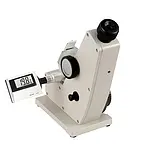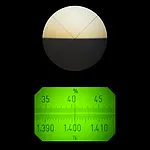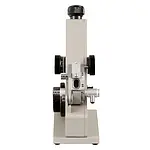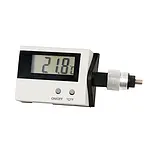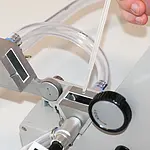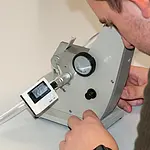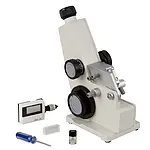Abbe refractometer for precise measurement of refractive index and sugar content /
Thermometer included / Temperature control of the prism holder possible /
For the analysis of fats, oils, paints, varnishes, foodstuffs and chem. substances
With the Abbe refractometer you get a measuring device for fast and precise determination of the refractive index nD between 1.300 and 1.700. The Abbe refractometer also measures the sugar content of translucent liquids, dispersions, emulsions or other substances. Using the supplied thermometer, the refractive index can be determined for a temperature range of 0 ... +70 °C. In order to control the temperature of the device, adapters for water hoses are attached to both sides of the Abbe refractometer on the upper and lower prism holders, which allow temperature control by means of an external thermostat. With this Abbe refractometer you can e.g. carry out an exact determination of the sugar content in the range 0 ... 95% (1.333 ... 1.531). The area of application is much wider: measurement and analysis of fats, oils, paints, varnishes, foodstuffs, chemical substances, alcohol and solvents.
How does an Abbe refractometer work?
A refractometer serves as a measuring device with which you can determine the refractive index. This works with both liquid and solid substances, as long as they are transparent, with the help of refractometry. After the sample has been applied to the refractometer, special optics in the refractometer create opposite light-dark fields, the borderline between the two fields is the measurement result of the sample.
Roughly speaking, one can differentiate between three measuring methods of a refractometer:
- Transmitted light
- Grazing incidence
- Total reflection
For this purpose, the refraction, i.e. the refraction or total reflection of the light and its physical properties are used. The common denominator of the three measuring principles presented is the measuring prism with a known refractive index. Light has the property that it does not move at the same speed at the transition between the measuring prism and the sample medium, but propagates at different speeds. The unknown refractive index of the medium to be measured is measured via the light deflection.
- With the transmitted light principle, a parallel beam of light is refracted at the interface between the two media.
- In the case of grazing incidence and total reflection, the critical angle of a beam is
measured with different angles of incidence on the interface.
The measurement result is most accurate at 20 °C, so the temperature should always be determined and the distortions determined using a correction table. However, there are also refractometers that have an automatic temperature correction which of course greatly increases the measuring comfort.
What is the Abbe refractometer used for?
Many applications aim to determine the concentration in a carrier medium. A traditional example is the determination of the sugar content in mostly aqueous solutions. For example, by determining the sugar concentration of a grape, its degree of ripeness can be determined, which makes it interesting for winemakers. The refractometer can also measure the original wort when brewing beer and the water content in honey. But a refractometer can also be a real aid in industry, for example the oil-water concentration in cooling emulsion mixtures in metalworking machines or the acid concentration in batteries can be determined. A refractometer can also be found in medicine, for example the protein content in urine can be measured. There are many other areas of application in which a refractometer is useful and greatly simplifies work. In order to ensure comparability of the results, separate scales have now been established (degrees Oechsle, degrees Brix, degrees Plato). Refractometers are mostly equipped with the double scale % mas sucrose (Brix)/°Oe or triple scale % mas sucrose (Brix)/°Oe/KMW-Babo. The % mas sucrose (Brix) scale is valid internationally. The Oechsle scale 0-140°Oe is valid for fruit juices, foreign grape musts and distilling mashes. For German grape musts only the Oechsle scale 30-140°Oe is valid. Refractometers with this scale are marked with a "D".
